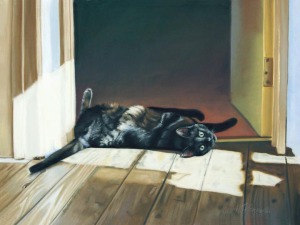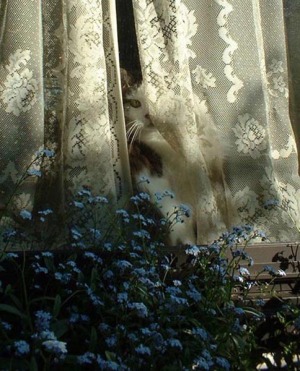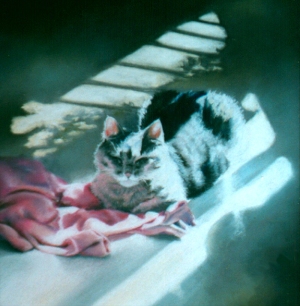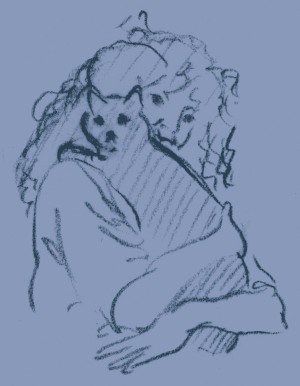To love that well, which thou must leave ‘ere long
First in a series of “pet loss and grief told from personal experience”

This week I’ll be writing about pet loss, beginning with my own recollections of “how I learned to lose”, and including interviews with persons who deal with pet loss and their journey to what they do for others, such as Deb Chebatoris of Chartiers Custom Pet Cremation, whose services I’ve used, and Karen Litzinger, author of Heal Your Heart: Coping with the Loss of a Pet, a pet loss CD I highly recommend. I’ll also feature a guest blog from Ingrid King, author of Buckley’s Story: Lessons from a Feline Master Teacher.
I’ve illustrated this writing with paintings, sketches and photos of my fondly-remembered kitties.
The title of this blog is a quote from Shakespeare’s sonnets, number 73, the final couplet of which reads:
This thou perceivs’t, which makes thy love more strong,
To love that well, which thou must leave ‘ere long.
Except in rare circumstances, we will always outlive our pets. It is best for them and for us to consider options and prepare, and to take care of ourselves afterward, in their memory. Let the knowledge that we will someday live without them strengthen our love for them and make each day with them all the more special.
I have the full sonnet at the end of this blog, because I thought it easier to understand after considering the process of loss.
My first loss

The first time I lost a cat, I did it all wrong.
There is no “right” way to lose a pet, but that first experience was a trauma in part because it was unexpected though it didn’t have to be, and because I didn’t know the first thing about what to do or what to expect when her time came.
From that, however, I learned to face the eventual loss of each of my cats and do my best to prepare for it, to monitor and learn about medical conditions and plan what I might do in various situations, and what I’ll do afterward, giving me some sense of control in a situation that is out of my control. And, while I’d rather share a happier lesson, I’ve been able to help friends and others to navigate their loss.
I have found my peace with my decisions about Bootsie because I now understand that I just didn’t know my options and I made the best decision I could. I relate the story, below, in the case that you may have made similar decisions and carry the burden of regret, or that you may be headed for a similar situation and wondering what you might be able to do.
About Bootsie

She had been my first cat, a Christmas present when I was nine years old. She was now fifteen and had had a persistent cough for several years, sometimes so prolonged that she would nearly flatten herself on the floor and cough until her nose began to turn blue, then wheeze for a while after the spasm was over.
Veterinarians had prescribed prednisone, which I gave to her each morning followed by Tender Vittles, Bootsie’s favorite. I shake my head in wonderment at my apathy about her condition, especially seeing the vigilance with which I now monitor each cat’s behavior. I never asked what she had, and in fact I think I didn’t know then that cats could “have” health conditions or diseases like people did. I think I just figured the cough would go away.
I know I never considered her death. She had always been there, and aside from the cough she was completely normal. If I thought anything, it was that she would live a long life and die in her sleep one night.
Now, at fifteen, her coughing spasms were growing noticeably longer and she seemed weak, so I took her to see a veterinarian and described the increased coughing spasms. Same dose of prednisone as before. This appointment was a Wednesday or Thursday.
On Saturday she barely ate in the morning, then went upstairs and laid on the bed, not curling comfortably, and seemed to be having some trouble breathing, rocking back and forth with the effort and quietly looking at me. Later she moved under the bed, very odd for her, and I could hear her wheezing and I had a sudden cold chill as some part of me realized she was in great pain and needed treatment.
Find an emergency clinic

Of course, all veterinarians were closed on Saturday night, and I had never had an emergency before, at least not as an adult. I had a vague recollection of taking a very sick kitten to an emergency hospital many years before, and I used this memory to decide that Bootsie couldn’t wait until Monday when I could call for an appointment.
I got the phone book and found an emergency clinic that sounded familiar, called and took Bootsie there at something like 2:00 in the morning. Driving there, trembling with cold fingers at the sound of her labored wheezing and the thought of what was to come, I knew she’d never come home again. I didn’t want to believe this, there were times when I simply thought the worst, especially when filled with worry, and I chalked it up to that.
The veterinarian knew immediately on hearing Bootsie’s breathing and seeing her normally bright pink nose and lips bluish in the white fur of her muzzle, but she listened and x-rayed before she gave me the news.
The diagnosis

As the veterinarian explained Bootsie had emphysema, patiently describing what the disease had done to her lungs and that the cough she had always had meant Bootsie had likely had asthma all her life, especially living in a house with heavy smokers as my parents had been, I couldn’t respond for the tears and felt my first regrets.
Why hadn’t I questioned those other veterinarians? Why had I just accepted the prednisone and not asked for an explanation? I would never accept that sort of thing again. I would never be caught off guard this way again. I especially never again wanted to feel the deep, painful guilt of that moment, realizing that Bootsie had been in pain for some time and I had had no idea and done nothing about it.
The veterinarian suggested that she keep Bootsie in the oxygen tent overnight and see how she was in the morning. Seeing the X-ray, it was doubtful she could survive for very long outside of the tent, but they could tell more after she had been stabilized.
She was somewhat better the next day, and on Monday morning they tried her outside the oxygen tent, but it was no use. There was no hope for her to live without supplemental oxygen, she would be in great pain, feeling as if she was smothering, her body failing from lack of oxygen to her organs and brain.
I begged them to set me up with a tent for her that I could take home, anything, I just couldn’t let her go this way, it was too much of a shock, but of course there was no home oxygen tent for a cat, and while I considered just taking her home, just to have her there one more time, I knew it would be horrible for her. Even with the oxygen she was failing.
The decision

I left work to go to the animal hospital. They brought Bootsie to me, weak and heaving to breathe now, and the veterinarian described the euthanasia process, a sedative to relax her, then the medication to stop the heart. I signed the papers, and then made the next decision I regret to this day.
I couldn’t be in the room when they did this, and I really didn’t ask why not. They asked me if I wanted to see her afterward and I said “no”, afraid they would think I was a little nutty wanting to see my cat when she was dead. They asked what I wanted to do with her body, and since I lived in an apartment and it was winter I wouldn’t bury her outside and I knew nothing of cremation for pets. I chose to have her buried in a common grave, somewhere, I have no idea where. And then I kissed Bootsie and handed her back to the vet and walked out, and I never saw her again.
The aftermath

I was haunted for months. I actually called a few days later and asked if they had really put her to sleep because I wanted to see her again. I developed a big complicated daydream about how they had decided to use her for an experimental lung transplant instead of putting her to sleep. I wrote the veterinarian a long letter with sketches of Bootsie in it, thanking her for her kindness.
I had had her put to sleep in April, and in the summer I still saw Bootsie out of the corner of my eye, felt her walk on me as I was falling asleep, felt that big stab of regret over and over when I remembered the moment I had told them “no”, I didn’t want to see her again, because that was all I wanted, just one more time.
The gifts of loss
The first gift her loss gave me was that I began writing again, and that was when I began fooling around with pencil and paper creating sketches of Bootsie; now, look where that got me.
The second gift was my resolve to learn more about the three cats I had then, about health and diet and youth and old age, and to start preparing myself well in advance of their loss so that I wouldn’t make a bad decision in that awful last moment ever again. In Bootsie’s honor, all my cats would live better lives.
And so the next time…

When I lost Kublai Khan ten years later in 1996, I distinctly remembered all the lessons I had learned with Bootsie. He and all the others had decidedly lived a better life as I learned more and more and had found a veterinarian who seemed to understand my need to know as much as possible and even taught me to perform care at home.
Even though we never had a full diagnosis of his condition, which was some auto-immune syndrome and so could have been any number of things from toxoplasmosis to FIP to simply an aggravated allergic response to fleas that went out of control, I participated in his care and learned to give sub-Q fluids and take temperatures and take care of bowel issues, but I won’t go into detail on that.
His passing was something I dwelt upon to prepare myself for every possible circumstance, and I spent as much time with him as possible doing things we’d always done to the extent that he could do them, and thereby realized the magic communication between my cats and me; I’ll write more about that later.
24 years later…
Bootsie was loss number one. Namir, who died on July 1, 2009, was loss number 12.

I went back through my files, with Mimi’s assistance, looking for the copy of the letter I had written to the veterinarian and some of those first sketches of Bootsie because I wanted to use at least the sketches here; I had seen it in one of my files within the past year, but no luck.
But the search took me down memory lane, because Bootsie’s treatment really marks the beginning of my journey with cats, as hers are the first records I kept. Looking at all the other paperwork, notes on conditions, big old envelopes with X-rays, rabies tags (I’ve resolved to make a mobile or wind chime out of them someday), I can see my path to where I am today. It really begins with the day I met Bootsie in the shelter, but the learning began in earnest the day I lost her.
I am glad for the lessons, and the ability to help others as well as myself.
Sonnet 73
William Shakespeare
That time of year thou mayst in me behold
When yellow leaves, or none, or few, do hang
Upon those boughs which shake against the cold,
Bare ruin’d choirs, where late the sweet birds sang.In me thou see’st the twilight of such day
As after sunset fadeth in the west;
Which by and by black night doth take away,
Death’s second self, that seals up all in rest.In me thou see’st the glowing of such fire,
That on the ashes of his youth doth lie,
As the death-bed whereon it must expire
Consum’d with that which it was nourish’d by.This thou perceiv’st, which makes thy love more strong,
To love that well which thou must leave ere long.
Next in this series: Starting with pet loss—before the loss: begin preparing yourself for loss by being proactive about care and providing palliative care yourself at home
Pet loss and grief told from personal experience
When I was losing a pet and making decisions, and after I had lost a pet and was dealing with grief, I was most comforted by hearing stories from others about their experiences. Sitting with one of my cats in the middle of the night, trying to determine if they were suffering in any way, if they were ready to let go, struggling to make the decision about euthanasia and what to do after they died, I felt so alone and only hearing what others had experienced and what they had decided helped me put my own situation and decisions into perspective, and let me know that I was not the only person to experience the anguish I was suffering. I’ve composed this series of articles in the hopes that others find comfort in my experiences and those of the others mentioned here, and that information included about services and products may help them in their decisions.
Read the other articles in this series:
To love that well, which thou must leave ‘ere long: my first and worst lesson in pet loss
Starting with pet loss—before the loss: begin preparing yourself for loss by being proactive about care and providing palliative care yourself at home
Options for “After Care”, featuring Chartiers Custom Pet Cremation: aftercare, and a profile of a business and a person I find exceptional, and exceptionally comforting
Heal Your Heart After Pet Loss, a Remarkable CD and Guidebook: your grieving process, and a very special CD and guidebook for those times when you need a comforting voice
Turning Loss into Creativity with Ingrid King and Buckley’s Story: how grief can become the catalyst for change, turning grief into a creative effort
Pet Loss Support Information: ideas and resources for where to find comfort and support in your loss, including books about and inspired by the author’s personal experience
Pet Love and Pet Loss, and How it Gave Me My Art: my own experience turning multiple losses loss into multiple creative endeavors
About the images used in this post
All of the images used here are of my cats, my inspirations and muses. I sell prints and notecards of all of them. It’s one of the things that helps me with losing them, to know that their image goes out in the world and they are thereby, in a way, immortal. To see the art visit my website and look under “Fine Art and Portraiture” for the gallery, “My Cats“. Also look under “Photography” for the five galleries of “My Cats“. You can browse prints and notecards in my “Marketplace“.


Pingback: Everything is a Metaphor - The Creative Cat
Pingback: Vintage Photo: A Sunny Room, 1983 - The Creative Cat
Pingback: The Creative Cat - Perhaps the Storm is Finally Over, 2012
Pingback: The Creative Cat - Vintage Photo: A Sunny Room, 1983
Pingback: A Sunny Room « The Creative Cat
Pingback: The Inspiration of a Certain Black Kitty « The Creative Cat
Pingback: Get Well Wishes for Peaches « The Creative Cat
Pingback: E-newsletter and Articles on The Creative Cat « What's New in Bernadette's Studio?
Pingback: Pet Love and Pet Loss, and How it Gave Me My Art « The Creative Cat